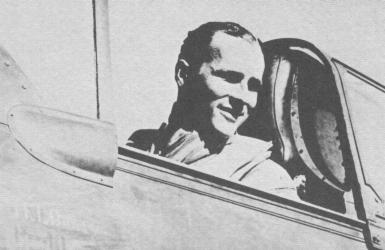| The Fall of Bataan | |||
| Home Page | Airmen Index | ||
 | |||
|---|---|---|---|
| Captain Ed Dyess and Captain Roland Barnick | |||
|
Christmas Day in the Philippines in 1941 was not a
happy one. Thousands of Americans and
Filipinos were retreating into Bataan Peninsula on
Luzon. P-40s were sent to two
small airstrips being readied on the Peninsula and
some of the fighter pilots were put into the infantry, since
there were no planes for them to fly,
and no place to fly from.
Captain Ed Dyess was one of these pilots. They gathered an odd assortment of weapons, including guns salvaged from crushed P-40s, and fitted them with homemade mounts. In the middle of January 1942, Dyess helped drive off a new Japanese invasion attempt on the west coast of Bataan itself. As soon as the new bases were ready at Cabcaben and Bataan airfields, General Harold H. "Pursuit" George, called Dyess and his men back to the 21st Squadron. At Bataan Field, Dyess found just five P-40s still in flyable condition. A few battered civilian planes called the "Bamboo Fleet"--an old biplane, a Beechcraft, a Bellanca, a Waco, and a Navy "Duck", salvaged from the waters around Bataan, tried to bring in supplies and evacuate important people. Dyess and his fellow pilots had little food left, and their fields were sometimes under direct fire from infiltrating Japanese jungle troops. The pilots often ate monkeys, lizards and anything else they could shoot. On March 2nd, the Japanese were reported making a landing in Subic Bay, on the northwest coast of Bataan. Dyess, who called his P-40 "Kibosh," got permission from General George to attack the invaders with 500-pound bombs. On his first mission he missed with his bomb, but sprayed the ships and barges with .50-caliber slugs. Loading up again, he dive-bombed a freighter from 10,000 feet, and pulling out at 2,000 feet, he hit it squarely. Debris and smoke mushroomed, as Kibosh strafed the area. On his third mission, Dyess hit an enormous supply dump on an island, in the middle of the Bay. Then, with his six machine guns, he attacked a transport, slipping out of Subic Bay. Incredibly, this ship caught fire and it too blew up. The Bay was a holocaust. Later, the Japanese claimed it had been raided by three flights of four-engine bombers. The other fighter pilots had been carrying the fight to the enemy too, but by the end of the day Ed Dyess' Kibosh was the only P-40 left on Bataan. On April 9th, Bataan surrendered. The last flight out was made in the Navy "Duck" piloted by Captain Roland Barnick. Dyess was supposed to go along, but refused. Five passengers, including Carlos Romulo, packed themselves into the amphibian, which was meant to carry only two. The battered "Duck" could climb to an altitude of only seventy-five feet, even when those aboard threw out everything--the floorboards, their clothing and baggage. The plane managed to get to Cebu without instruments. Ed Dyess along with thousands of other Americans, went to Marivelles Airfield, where he surrendered. Of course, many Americans managed to escape to Corregidor Island, which succumbed a month later, and some got to Australia. Buzz Wagner for instance, had been wounded in the eye, and was sent out too late, to ferry P-40s back to Bataan. The story of Bataan is an unusually courageous one, and the P-40, and her brave pilots wrote a particularly memorable chapter in the history of fighting men. After the war, General Henry "Hap" Arnold said, "But for the P-40, the Japanese would have come all the way to Australia." |
© The Aviation History On-Line Museum. 2006 All rights reserved.